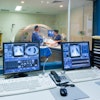Monday, November 26 | 11:50 a.m.-12:00 p.m. | SSC15-09 | Room E352
German researchers plan to show how 3D contrast-enhanced MR angiography can help clinicians with vascular intervention before prostatic artery embolization.Two radiologists retrospectively evaluated contrast-enhanced MR angiography studies from 28 patients (mean age, 68.2 years) prior to embolization. The exams were performed on a 3-tesla MRI scanner, and reconstructed 3D images also were obtained. They then used a scoring system from 0 to 2, with 0 indicating the artery was not seen or interrupted or its origin could not be identified, and 2 meaning the artery was clearly visible.
Across a total of 56 internal iliac arteries and nine different branches, scheduled presenter Dr. Nagy Naguib from Frankfurt University Hospital and colleagues recorded scores of 2 and sensitivity of 100% in the superior gluteal, inferior gluteal, obturator, and iliolumbar arteries. Prostatic artery detection was successful in 26 cases with scores of 2 and sensitivity of 80%.
The researchers noted a few exceptions to the promising results. The middle rectal artery achieved a sensitivity of 38%, followed by the superior vesical artery with a sensitivity of only 4%.
3D contrast-enhanced MR angiography is a "reliable method for mapping the internal iliac artery prior to prostatic artery embolization, which might help in reducing the procedure time," they concluded.



.fFmgij6Hin.png?auto=compress%2Cformat&fit=crop&h=100&q=70&w=100)




.fFmgij6Hin.png?auto=compress%2Cformat&fit=crop&h=167&q=70&w=250)











